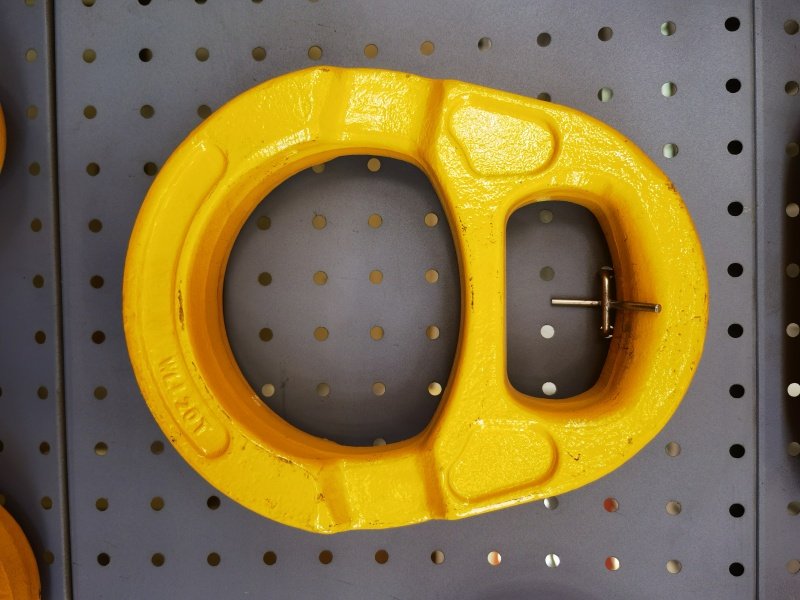How Does the Kelly's Eye G80 Protect Industrial Safety?
Imagine this: On a construction site dozens of stories high, workers are using cranes to lift multi-ton steel beams. Amidst turbulent seas, a massive cargo ship is securely tied to the dock. Even at a remote wind farm, wind turbine blades are precisely installed hundreds of meters above the ground... Behind these thrilling scenes lies an unsung "safety guardian"—the shackle.
The Kelly's Eye G80 shackle we'll introduce today is a true "all-around champion" in this field. What makes it so special? Let's start from the beginning.
Ⅰ. Why Are Shackles so Important?
If you compare lifting operations to a "high-altitude relay race," the shackle is the "critical link" connecting each baton. It must simultaneously meet three demanding requirements:
Strong enough: able to withstand loads weighing several or even hundreds of tons without breaking;
Flexible enough: able to seamlessly work with various tools, such as wire rope, chain, and slings;
Durable enough: able to maintain stable performance despite exposure to wind, sun, and repeated use.
While traditional shackles can perform their basic functions, they are prone to failure in extreme environments (such as excessive weight, corrosion, and frequent use). The Kelly's Eye G80 has completely changed this situation.
II. The "Hard-Core Strength" of the Kelly's Eye G80
This shackle's "superpowers" stem from three secret weapons:
1. Steel: A tensile strength of 930 MPa, exceeding the industry standard by 16%.
Material Properties: Made of Cr-Mo-V high-alloy steel (compliant with DIN 1674), it boasts a tensile strength of 860-1000 MPa, a 16% increase over the 800 MPa required by EN 1677. Process Advantages: After undergoing two high-temperature quenching steps—oil quenching at 1050°C and tempering at 580°C—it achieves a hardness comparable to automotive gears, yet is 20% lighter than ordinary steel.
Data Support: Taking the M36 specification as an example, it weighs only 3.2 kg and is designed with a 4x safety factor, boasting a rated load of 25 tons and a breaking load of 100 tons—equivalent to easily lifting five adult African elephants (approximately 25 tons)!
2. Smart Design: 2 Million Cycles of Fatigue Life
Structural Optimization: Using CAE topology to simulate tens of millions of stress scenarios, the traditional right-angle transition was replaced with a "teardrop" design, reducing stress concentration by 40%.
User Feedback: Comparative testing by a construction company showed that the G80 passed the ISO 8792 dynamic load test (1.5 times the rated load x 2 million cycles), extending its lifespan by 200% compared to traditional shackles. 3. Error-Proofing Technology: Three-Color Safety Levels
Coding System: Each shackle is laser-engraved with a unique code and color label (compliant with ISO 12100 standards):
Red: 25-ton class (super-heavy-duty operations), Yellow: 16-ton class (general industrial use), Blue: 8-ton class (light equipment lifting). Workers can quickly match the color to the required task, completely eliminating the safety hazard of "a small horse pulling a heavy cart."

III. What "Tough Tests" Can it Withstand?
To prove its strength, the G80 shackle proactively underwent a series of "abnormal" challenges:
Strong pull test: Under 2.5 times the rated load (e.g., a 25-ton shackle withstands 62.5 tons of tension) for 5 minutes, the deformation is less than 0.5 mm.
High-altitude drop test: After a free fall from a height of 1 meter, the structural integrity retention rate reaches 92%, while traditional shackles only maintain a 75% rate. Salt Spray Corrosion Test: 720 hours of neutral salt spray testing according to ASTM B117 (equivalent to three years of use in a coastal environment) yielded a surface rust rate of ≤3%, significantly lower than the industry average of 8-15%.
Note: The industry's standard salt spray test requirement is 500 hours, but the G80 far exceeds this standard.
IV. Where the G80 Shackle is a "Standard"
Construction Industry: It has been involved in super-tall projects such as the 800-meter landmark project in the Middle East and the Shanghai Tower.
Marine Engineering: Drilling platforms in the Norwegian North Sea rely on it to withstand a Category 12 typhoon.
New Energy Industry: German offshore wind farms specify the G80 for lifting giant blades.
International Certifications: It has received TÜV SÜD type approval, DNV GL marine certification, and the International Lifting Association's "Innovation Gold Award." Experts cite it as "redefining safety standards for industrial connections."
V. Why is it Considered "Cost-Effective and Worry-Free"?
Although the G80 is 10%-15% more expensive than ordinary shackles, its long-term operating costs are lower:
Service life: The G80 can last over five years, while ordinary shackles only last two.
Maintenance frequency: The G80 requires only one maintenance session per year, while ordinary shackles require quarterly maintenance.
Downtime losses: The G80's average annual downtime losses due to failures are virtually zero, while ordinary shackles average over 50,000 yuan.
Case study: After switching to the G80, a logistics company saved enough in annual repair and compensation costs to purchase 100 new shackles!
Conclusion: Safety is Paramount, so Choose Carefully.
In the industrial world, a single shackle can determine the success or failure of an entire project, or even the lives of personnel. The Kelly's Eye G80 uses technology and craftsmanship to breathe new life into this traditional tool.
The next time you see tall buildings rising from the ground and giant ships sailing through the waves, think about this: behind these magnificent scenes, there may be a G80 shackle silently guarding every bit of weight and every bit of trust.
Related Links:
Is GB/T 24816-2017 the standard for G80 in China?
What are Ratchet Load Binders ? What are Lever Binders?
G80 VS. G70 Chain: Key Differences in Lifting & Transport Chains


